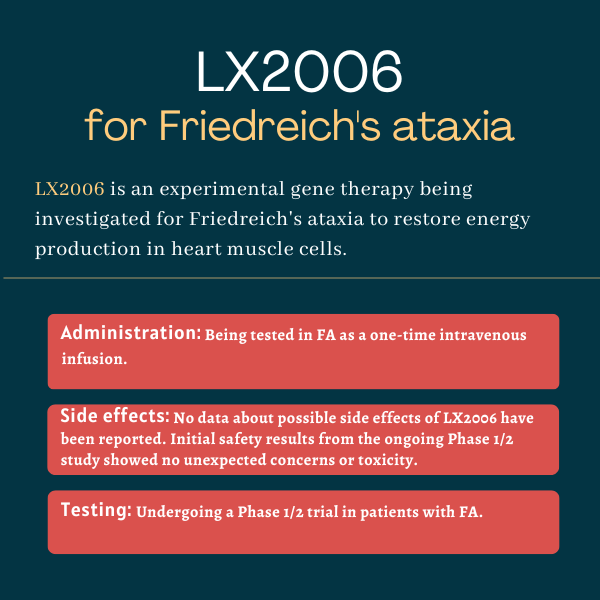LX2006 for Friedreich’s ataxia
What is LX2006 for Friedreich’s ataxia?
LX2006 is an investigational gene therapy for heart disease in people with Friedreich’s ataxia (FA).
The therapy, being developed by Lexeo Therapeutics, is intended for cardiomyopathy in FA. Cardiomyopathy is a disease of the heart muscle that can affect the heart’s size, shape, thickness, and function. Heart disease is the primary cause of death in FA patients.
Therapy snapshot
| Treatment name: | LX2006 |
| Administration: | Being tested in FA as an intravenous infusion |
| Clinical testing: | In a Phase 1/2 trial for FA |
How does LX2006 work in FA?
FA is caused by mutations in the FXN gene, which contains instructions for producing frataxin, a protein important for the functioning of mitochondria, the cell’s energy production centers. Frataxin deficiency results in damage to nerves and muscles.
Most FA patients develop heart abnormalities, including cardiomyopathy. Some symptoms that are common among FA patients with heart problems include extreme fatigue, chest pain, shortness of breath, and abnormally rapid or irregular heartbeat.
LX2006 is designed to promote frataxin production to restore normal mitochondrial function and energy production in heart muscle cells. It delivers the human FXN gene to these cells, and is packaged in a modified and harmless adeno-associated virus.
Preclinical studies, including those in an FA mouse model, found LX2006 safely and effectively improved heart function and survival, and had a favorable safety profile. The studies supported regulatory clearance to start clinical testing.
How will LX2006 be administered in FA?
In a Phase 1/2 clinical trial in FA patients with cardiomyopathy, LX2006 is being administered once by intravenous (into-the-vein) infusion. Three doses are being tested — a low, a mid, and high dose.

LX2006 in clinical trials
LX2006 is being assessed in an open-label Phase 1/2 study called SUNRISE-FA (NCT05445323), which is designed to test the gene therapy in about nine FA patients with cardiomyopathy over a first period of 52 weeks (one year). Participants will continue to be evaluated for an additional four years to monitor its long-term safety and efficacy.
SUNRISE-FA is a dose-ascending trial testing a low, a middle, and a high dose of LX2006, given intravenously. The trial is open-label, meaning it doesn’t have a control group. Its primary objective is to assess the safety and tolerability of the three doses. Cardiac function and fibrosis (scarring), the presence and severity of irregular heartbeats, levels of relevant biomarkers, and other preliminary efficacy measures will also be analyzed.
Eligible participants are 18-40 years old, with FA onset before age 25.
The study is recruiting participants in the U.S. and Canada. The estimated trial completion date is September 2029.
Common side effects of LX2006
Although it’s still too early to know the possible side effects of LX2006, the therapy was found to be well tolerated and not associated with unexpected safety concerns or toxicity in a first group of patients treated in the SUNRISE-FA trial.
Friedreich’s Ataxia News is strictly a news and information website about the disease. It does not provide medical advice, diagnosis, or treatment. This content is not intended to be a substitute for professional medical advice, diagnosis, or treatment. Always seek the advice of your physician or other qualified health provider with any questions you may have regarding a medical condition. Never disregard professional medical advice or delay in seeking it because of something you have read on this website.
Recent Posts
Related articles

 Fact-checked by
Fact-checked by 



